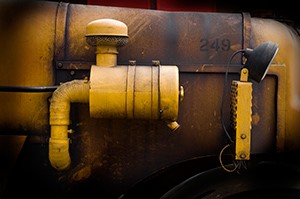Controlling the hazards of diesel exhaust

Workers in railroads, oil and gas, construction, mining, agriculture, transportation, and many other industries may use diesel to power vehicles and equipment. The Occupational Safety and Health Administration (OSHA) stresses the need to properly control diesel exhaust because of health issues that can be caused by exposure to the dangerous mixture of gases and small particles found in the exhaust. Engineering controls, administrative controls, and personal protective equipment (PPE) can help reduce illness in workers exposed to diesel exhaust.
Diesel particulate matter (DPM) is a component of diesel exhaust (DE) that contains soot particles made up of ash, carbon, metallic abrasion particles, sulfates, and silicates. Short-term exposure to high concentrations of DPM can result in dizziness, headaches, and irritation of the eyes, nose, and throat. Lengthy exposure can increase a worker’s chance of developing lung cancer and cardiovascular, cardiopulmonary, and respiratory diseases.
According to OSHA, engineering controls are the most effective method for reducing exposure to diesel exhaust. The best strategy often requires a combination of the following:
• Routinely maintaining engines to minimize emissions
• Installing exhaust filters on engines
• Choosing cleaner burning engines
• Installing diesel oxidation catalysts
• Using special fuels or fuel additives, like biodiesel
• Filtering air in equipment cabs
• Installing or improving ventilation systems to capture and remove emissions in indoor facilities
Administrative controls can be another effective way to reduce diesel exhaust exposure. OSHA defines administrative controls as “changes in the way work tasks are performed to reduce or eliminate the hazard.” Some examples are:
• Limiting vehicle speeds
• Reducing traffic congestion by using one-way travel routes
• Eliminating or decreasing unnecessary idling or engine lugging
• Use traffic safety cones, posts, barricades, and barrels to designate areas where diesel engines are prohibited and foot traffic is allowed
• Limiting the amount of total engine horsepower and diesel-powered equipment running in one area and ensuring those numbers do not exceed the ventilation system capacity
Personal protective equipment may also help to reduce health issues when worker exposure reaches certain levels. For example, the Mine Safety and Health Administration (MSHA) requires miners to wear respiratory protection when engineering and administrative controls do not reduce a worker's exposure to an acceptable level.
Protect crews that work with diesel-powered equipment. Train workers to understand hazards, implement effective controls, and provide respirators to reduce the risk of illness that can be caused by exposure to diesel exhaust.



